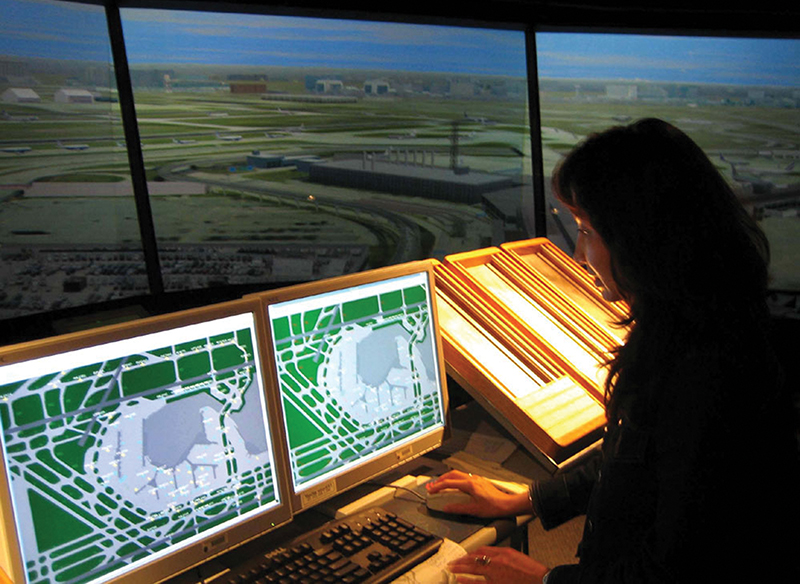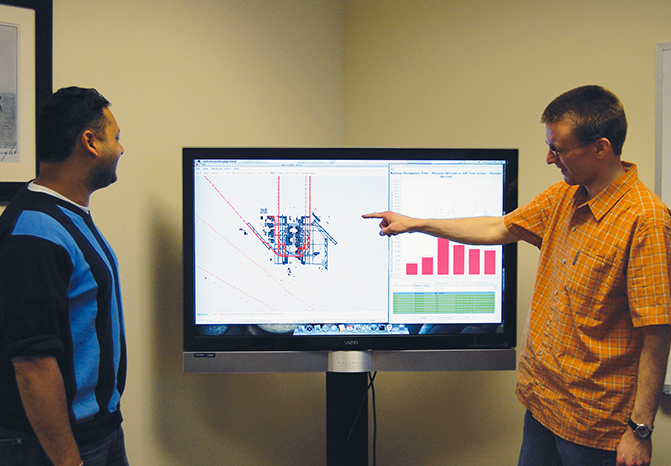
Surface Operations Systems Improve Airport Efficiency
Originating Technology/NASA Contribution
As part of its research to make air travel safer, NASA began collaborating with the Federal Aviation Administration (FAA) in 2005 to develop what are now called surface traffic management systems (STMS). Both agencies have expressed a need to gather and organize data on airport surface operations, the management of all airport vehicle activities on or near runways, including the movement of aircraft, baggage vans, fuel trucks, catering vehicles, security personnel, and any other ground traffic. STMS continuously record data to determine the position of aircraft using a transponder signal, GPS onboard the aircraft, or primary radar. These surface surveillance systems, which report locations every second for thousands of air and ground vehicles, generate massive amounts of data, making gathering and analyzing this information difficult. To record and help analyze airport operations data with the eventual goal of automating airport ground traffic, NASA sought assistance from private industry.
Partnership
In 2005, Mosaic ATM Inc., of Leesburg, Virginia, developed the Surface Operations Data Analysis and Adaptation (SODAA) tool with funding from Ames Research Center through the Small Business Innovation Research (SBIR) program. In essence, says Chris Brinton, Mosaic ATM’s president and a former Ames employee, “SODAA is an off-line support tool that can be used to analyze how well the airport surface operation is working, and to help in redesigning procedures and decision-making processes to improve airport operations.” Mosaic ATM continued its work with a Phase II SBIR in 2006.
After identifying what NASA, the FAA, and the aviation industry required, Mosaic ATM built and then systematically improved upon a prototype for SODAA. These improvements included advanced query, visualization, and data analysis capabilities to allow researchers to pinpoint trends and correlations in vast amounts of recorded airport operations data. Now widely used, SODAA has two main capabilities: supporting analysis of surface operations and developing STMS adaptation data, which provide airport configuration parameters for STMS. Mosaic ATM designers have also made a special effort to reduce the time needed to build STMS adaptation data sets, with options that include predefined functions.
Product Outcome
Mosaic ATM’s SODAA helps airports and carriers avoid the significant costs of aviation delays by providing analysis tools to help refine and improve airport operational procedures. Even a small airstrip manages numerous variables for each aircraft and ground vehicle, and collecting data 24 hours a day on hundreds of different vehicles and situations can become unwieldy quickly. Working with current airport surface surveillance systems, SODAA manages these large amounts of data, revealing where slowdowns or irregularities occur.
SODAA presents this data in a graphical user interface (GUI), allowing for immediate, useful interpretation, such as when changes in the flight schedules at the airport cause inefficiencies. Using the GUI, users can define queries—and areas of concern—which SODAA can plot on a map, display in a graph or a table, or export to other software. SODAA pulls raw airport data and STMS log files into its database, and then flags data that may be of interest.
SODAA imports data after receiving updates from the STMS, which allows for post-operations analysis for a variety of uses: long-term airport planning, highly accurate operations billing, assessing noise abatement issues, and routine management of ground traffic. Based on the data it collects, SODAA identifies busy runway crossings and choke points, calculates waiting times and taxi times, and determines how frequently and for what duration taxiways and runways are used. The software analyzes these runway assignments, flight profiles, and taxi routes in order to help managers make key decisions and be alert to potential or recurring slowdowns; SODAA displays key factors like proximity to a conflict point, such as a bottlenecked runway, taxiway, or ramp area. SODAA can then create new scenarios for departure and arrival traffic by using customized management strategies. Airport planners can also adapt the tool to suit different needs and conditions, such as a taxiway that cannot be used on certain dates due to construction.
In addition to inefficiencies, the SODAA tool can also help analysts recognize possible safety concerns, such as a particular driver who regularly follows the wrong route. By preventing or catching a surface deviation early, an analyst or airport manager may help avoid a costly or dangerous delay. User-friendly graphics also allow users to view these vehicle paths, and to drill down to see more specific information and statistics, such as how closely and regularly a vehicle is adhering to its assigned route, and how often it is out of compliance.
In order to create detailed views of the various airport operation levels, the software uses statistical correlation, clustering, and modeling in its data analysis. Brinton explains that these analytical techniques allow information about the airport operation to be automatically derived by SODAA and provided to the user. “For example,” Brinton says, “if flights parked at one concourse experience more delays than flights parked at other concourses, SODAA will identify this correlation and display it to the user.” This analysis depends on the collection of large amounts of surface data from STMS to identify consistent characteristics.
Customers such as air traffic specialists, airline managers, and airport authorities use SODAA to improve operations efficiency and to help make long-term planning decisions at airports. Brinton explains, “The significant costs of aviation delays and the opportunity to reduce such delays through this effort result in a strong market for the SODAA technology.” Currently, Mosaic ATM continues the commercialization and development of SODAA under a Phase III SBIR contract.

In 2005, Mosaic ATM Inc. developed Surface Operations Data Analysis and Adaptation (SODAA), an off-line support tool for analyzing and improving airport surface operations.

The Aviation Systems Division at Ames Research Center has contributed to surface automation research by helping to develop surface traffic management systems, which are decision-support tools designed to aid surface traffic planning.













